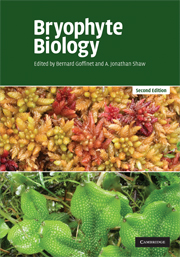Book contents
- Frontmatter
- Contents
- List of contributors
- Preface
- 1 Morphology and classification of the Marchantiophyta
- 2 Morphology, anatomy, and classification of the Bryophyta
- 3 New insights into morphology, anatomy, and systematics of hornworts
- 4 Phylogenomics and early land plant evolution
- 5 Mosses as model organisms for developmental, cellular, and molecular biology
- 6 Physiological ecology
- 7 Biochemical and molecular mechanisms of desiccation tolerance in bryophytes
- 8 Mineral nutrition and substratum ecology
- 9 The structure and function of bryophyte-dominated peatlands
- 10 Population and community ecology of bryophytes
- 11 Bryophyte species and speciation
- 12 Conservation biology of bryophytes
- Index
- References
10 - Population and community ecology of bryophytes
Published online by Cambridge University Press: 06 July 2010
- Frontmatter
- Contents
- List of contributors
- Preface
- 1 Morphology and classification of the Marchantiophyta
- 2 Morphology, anatomy, and classification of the Bryophyta
- 3 New insights into morphology, anatomy, and systematics of hornworts
- 4 Phylogenomics and early land plant evolution
- 5 Mosses as model organisms for developmental, cellular, and molecular biology
- 6 Physiological ecology
- 7 Biochemical and molecular mechanisms of desiccation tolerance in bryophytes
- 8 Mineral nutrition and substratum ecology
- 9 The structure and function of bryophyte-dominated peatlands
- 10 Population and community ecology of bryophytes
- 11 Bryophyte species and speciation
- 12 Conservation biology of bryophytes
- Index
- References
Summary
Introduction
Modern textbooks in general ecology contain very few, if any, bryophyte examples of patterns and processes such as population and metapopulation dynamics, dispersal, competition, herbivory, and species richness variation. A question then arises: can we freely adapt theories developed from studies of vascular plants or even animals and apply them to bryophytes? In this chapter I give examples of population and community-level processes based on bryophyte studies, and discuss how life history, morphology and physiology of bryophytes can help us to understand population dynamics, community diversity, and species composition.
Bryophytes are important in terms of species richness and cover in many habitats, and also for ecosystem functions. Most obvious is the role of Sphagnum as peat former. A calculation based on an average peat depth of 2 m indicates that the amount of carbon in northern hemisphere peatlands is 320 Gt, about 44% of the amount held in the atmosphere as carbon dioxide (Rydin & Jeglum 2006; see Chapter 9, this volume). Another example is the finding that nitrogen-fixation by the cyanobacterium Nostoc associated with Pleurozium schreberi contributes substantially to the nutrient budget of boreal forests (DeLuca et al. 2002). An illustration of the community importance of bryophytes is their contribution to biodiversity in many ecosystems at northern latitudes. As an example, Sweden hosts c. 0.8% of the world's vascular plant species, and 7.5% of the bryophytes (Table 10.1).
- Type
- Chapter
- Information
- Bryophyte Biology , pp. 393 - 444Publisher: Cambridge University PressPrint publication year: 2008
References
- 10
- Cited by



